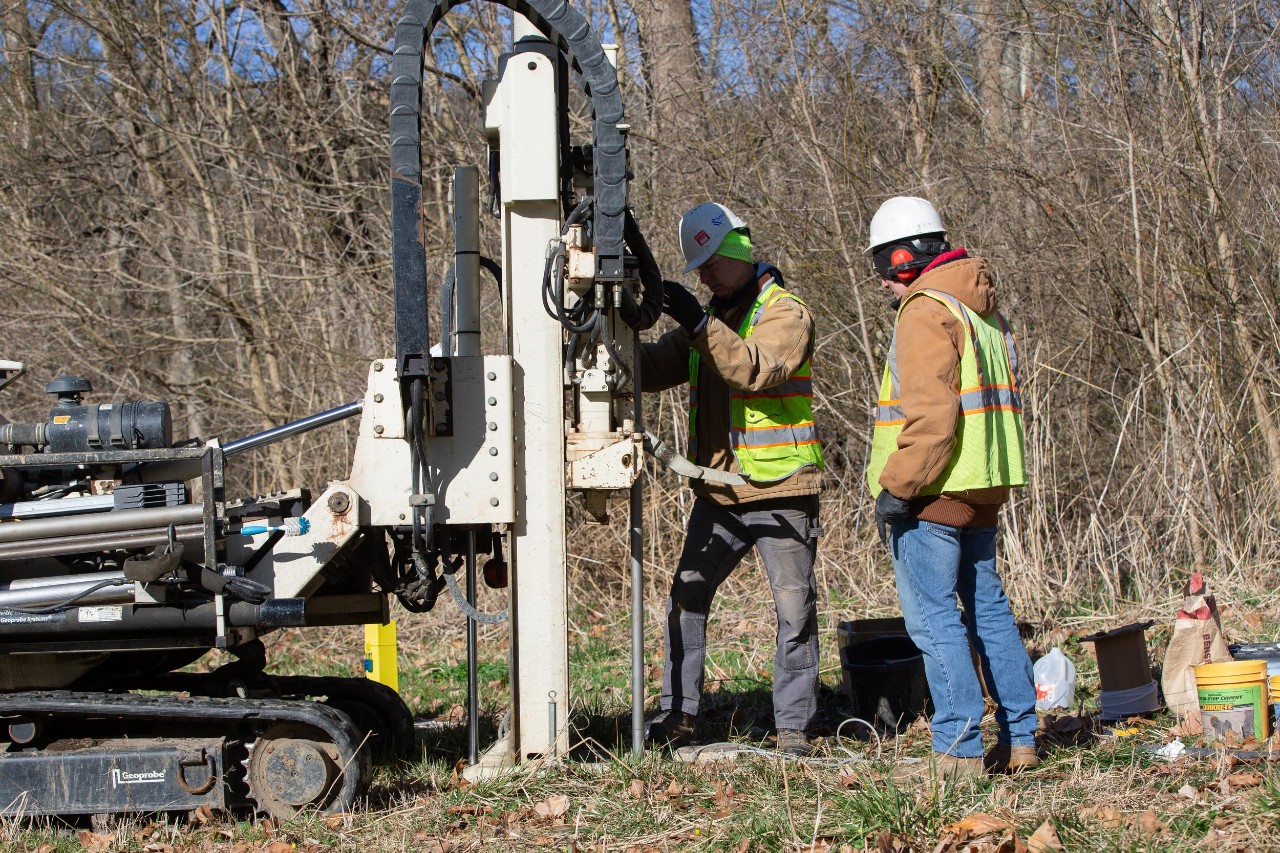
UC launches pioneering study of 'forever chemicals' in drinking water
Researchers turn their focus to water quality along Great Miami River
The University of Cincinnati is at the forefront of a groundbreaking research project studying the complex interactions between groundwater and surface water along the Great Miami River.
Conducted at UC’s Theis-Nash Environmental Monitoring and Modeling Site, the project focuses on the water and chemical processes that control the fate and transport of nutrients such as nitrate along with toxins, particularly the notorious “forever chemicals” known as per- and polyfluoroalkyl substances or PFAS.
In collaboration with the Environmental Protection Agency and the Pacific Northwest National Laboratory, UC’s Department of Geosciences and Department of Biological Sciences are investigating how these substances migrate into and transform within underground aquifers, crucial sources of drinking water for more than 2 million Ohioans.
UC's team is trying to understand what happens to toxins such as PFAS, or “forever chemicals,” that leach into groundwater and how these systems differ from surface water in lakes, rivers and reservoirs.
Named for Professor Emeritus David Nash and the distinguished late hydrogeologist C.V. Theis, the observatory is equipped to monitor these dynamic water interactions, particularly during significant hydrological events such as floods which are increasingly prevalent due to climate change.

Geoscientists for years have used UC's Theis-Nash Environmental Monitoring and Modeling Site to understand how water flows through the aquifer along the Great Miami River. Now they are turning their attention to understanding toxins such as PFAS in the water. Photo/Andrew Higley/UC Marketing + Brand
The monitoring site initially provided researchers with real-time data about the hydrodynamics of river water as it moves through a nearby aquifer, particularly during periodic floods. Now, researchers are turning their attention to chemicals in both the river and the groundwater.

Associate Professor Reza Soltanian is leading a project to study toxins in groundwater. Photo/Andrew Higley/UC Marketing + Brand
“We’re close enough to get surface water mixing with groundwater. Surface water is impacted by nutrients and agricultural runoff. But groundwater is also affected by those same things,” Associate Professor of Geosciences Reza Soltanian said.
Researchers kicked off the investigation at the site with scientists from the Pacific National Laboratory while work crews dug additional monitoring wells for the new study.
In her biology lab, UC Assistant Professor Annette Row studies environmental microbiology and water quality, among other topics.
Students used pumps to collect water samples from the wells on site, also gathering samples for microbial DNA and RNA analysis to study the aquatic microorganisms present.
Researchers were pleased that the samples they took corresponded to a coincidental period when the river flood level was up, allowing them to record these unique observations and gain insights into how microbial communities respond to changing water conditions.
“The movement and quality of groundwater are closely tied to the subsurface geological architecture," Soltanian explained. “The composition of the geology — ranging from silt and sand to gravel — controls the extent of groundwater and river water mixing. These geological characteristics not only determine the flow rates of water but also significantly influence the distribution of organic matter and microbial populations within the aquifer.”

Assistant Professor Annette Rowe studies applied and environmental microbiology in her lab. Photo/Andrew Higley/UC Marketing + Brand
Researchers investigate the concentrations of redox-active elements, including oxygen, in the water along with levels of oxygen-consuming organic matter. This comprehensive analysis of redox conditions provides critical insights into how microorganisms in the aquifer's sediments consume carbon and influence the geochemical environment.
Understanding these dynamics is essential for assessing how microbial activity affects the transformation and mobility of toxins in groundwater, ultimately impacting the quality of drinking water extracted from beneath the aquifer.
“When you look at groundwater, you have to make a lot of inferences,” Rowe said.
But UC’s project will allow researchers to study chemicals at locations throughout the aquifer using sophisticated equipment such as Fourier Transform Ion Cyclotron Resonance Mass Spectrometry at the U.S. Department of Energy’s Environmental Molecular Sciences Laboratory.
“Surface water is impacted by nutrients and runoff. Groundwater is also affected by those same things,” Soltanian said.
Soltanian emphasized that climate change is intensifying the frequency and severity of flooding events, heightening the urgency of this study. Understanding how these changes affect water quality is crucial for the well-being of communities that rely on these water sources.
Featured image at top: Workers dig a new monitoring well. Researchers in biology and geosciences launched a new project to study excess nutrients and contaminants in drinking water. Photo/Andrew Higley/UC Marketing + Brand.

UC graduate assistant Margaret "Megan" Naber, Assistant Professor Annette Rowe and Associate Professor Reza Soltanian are studying toxins in groundwater along the Great Miami River. The aquifer provides drinking water to many residents of Southwest Ohio. Photo/Andrew Higley/UC Marketing + Brand

UC graduate assistant Margaret "Megan" Naber said researchers want to study the microbiological processes that happen when surface water laden with toxins and excess nutrients like phosphorous and nitrogen mix with groundwater that has been stored deep underground for far longer. Photo/Andrew Higley/UC Marketing + Brand

UC researchers are collaborating on a project to examine the interaction of toxins such as PFAS in groundwater. Photo/Andrew Higley/UC Marketing + Brand

UC students use a pump to collect a water sample from a monitoring well at UC's groundwater monitoring site on the Great Miami River. Photo/Andrew Higley/UC Marketing + Brand

UC students collect their first water samples for a new collaboration with the Environmental Protection Agency and the Pacific Northwest National Laboratory to study nutrients and toxins in groundwater. Photo/Andrew Higley/UC Marketing + Brand

UC students collect the first water samples for a new study examining nutrients and contaminants in groundwater. Photo/Andrew Higley/UC Marketing + Brand
Next Lives Here
The University of Cincinnati is leading public urban universities into a new era of innovation and impact. Our faculty, staff and students are saving lives, changing outcomes and bending the future in our city's direction. Next Lives Here.
Related Stories
UC launches pioneering study of 'forever chemicals' in drinking water
May 2, 2024
UC is launching a new investigation to examine excess nutrients and contaminants in groundwater that provides drinking water for 2 million Ohioans.
Hungry eyes: Spiders lose vision when they’re starving
April 20, 2023
Biologists at the University of Cincinnati discovered that underfed jumping spiders lose light-sensitive cells that are key to their vision.
Biology student tackles big invasives problem
March 18, 2025
UC biology student Griffin Paul is studying the best ways to remove invasive Amur honeysuckle without using chemical herbicides.
